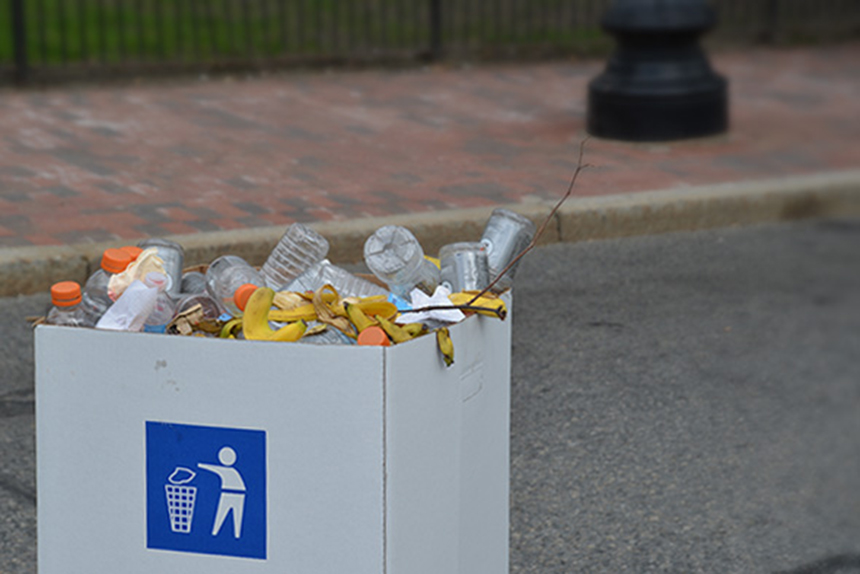Let Worms Do Your Home and Office Composting
May 14, 2010
KINGSTON, R.I. — Sejal Lanterman has kept worms under her kitchen sink, and currently has some in the basement and at the office. She believes every classroom should feature a bin of worms, and she spends the occasional Sunday relaxing by separating home and/or office worms from their castings.
“Worms are great for classrooms,” said Lanterman, the composting and recycling program manager for the University of Rhode Island’s College of the Environment and Life Sciences. “They’re a great learning tool, and they get kids to eat healthier. The kid who comes in with a bag of Doritos can’t feed the worms anything because all he has is garbage. The kid who comes in with a banana has the peel to feed to the worms.”
Lanterman keeps and feeds red wigglers because these small worms generate vermicompost, a heterogeneous mixture of decomposing food waste, worm castings (worm manure) and bedding materials — damp shredded newspaper and coconut coir work best. This nutrient-rich mixture reduces the need for fertilizer and is an excellent plant food.
This worm-based composting set-up also reduces the amount of waste that is unnecessarily buried at the Central Landfill in Johnston, since red wigglers enjoy dining on a variety of food scraps. Except for citrus, worms will eat all kinds of fresh fruits and vegetables. They’ll also feed on pet hair, coffee grinds, tea bags and eggshells.
A pound of red wigglers will eat between 1.5 and 2 pounds of food scraps a week.
The Kathleen M. Mallon Outreach Center keeps a blue bin of them, and the worm castings produced are used to feed the center’s many indoor plants. Interns do most of the separating of the worms from their castings, unless of course, Lanterman needs to relax.
Worms, however, are just one way of composting household and/or office food scraps. A compost pile is a good way to keep organic waste out of the state landfill. The key to managing such a pile, Lanterman said, is making sure you get the recipe right. She recommends sticking to a ratio of three parts brown (carbon) — leaves, straw, corn and tomato stalks, newspaper and cardboard, wood chips and pine needles — to one part green (nitrogen) — fruit and vegetable scraps, non-diseased expired plants, manure, coffee grinds, tea bags and chemical-free grass clippings.
Don’t compost meat, bones, fat, grease, oils, peanut butter, dairy products, cooked foods with sauces and butter, dog and cat feces, cat litter, diseased plants and weeds.
“A lot of people compost but not in the right way,” Lanterman said. “That’s still good, but it just takes longer to create good compost — two to three years instead of nine to twelve months.”
The right balance also helps neutralize unwanted odors and keeps curious animals, such as skunks and raccoons, away.
If, for example, your compost pile has too much nitrogen-rich green material, it will become sludgy, stinky — a rotten eggs-like smell — and the microorganisms that break down the waste will lack an energy source, which is provided by carbon-rich debris. An excellent brown source is shredded or torn-up newspaper, which features soy-based ink.
To avoid this problem, Lanterman recommends keeping a bin of brown material next to your compost pile, to provide coverage anytime green material is added. She also said composters should infuse their piles with oxygen up to three times a week, with a pitchfork, shovel, metal bar or compost aerator.
“Learning to blend materials together is the art of composting,” said Lanterman, who likes to experiment more than most. She routinely maintains four or five compost piles — each contained in a three-sided structure made of wood pallets — in her backyard. She said two works best for most people, though.
For those who live in more urban settings, an enclosed bin is a better option. You can compost in almost anything, from a specially designed contraptions to a trash barrel poked with holes.
And for those without access to a yard and not interested in sharing inside space with worms, indoor composters are available. URI’s Kathleen M. Mallon Outreach Center uses a NatureMill compost bin. They cost about $200 and use 50 cents of energy a month, according to Lanterman.
“We throw our leftover Chinese food and moldy stuff we find in the refrigerator right into it,” said Lanterman, who advises against throwing leftover take-out food into an outdoor compost pile or bin. “It can compost almost anything, except peach and avocado pits.”
Categories
Join the Discussion
View CommentsYour support keeps our reporters on the environmental beat.
Reader support is at the core of our nonprofit news model. Together, we can keep the environment in the headlines.
We use cookies to improve your experience and deliver personalized content. View Cookie Settings



